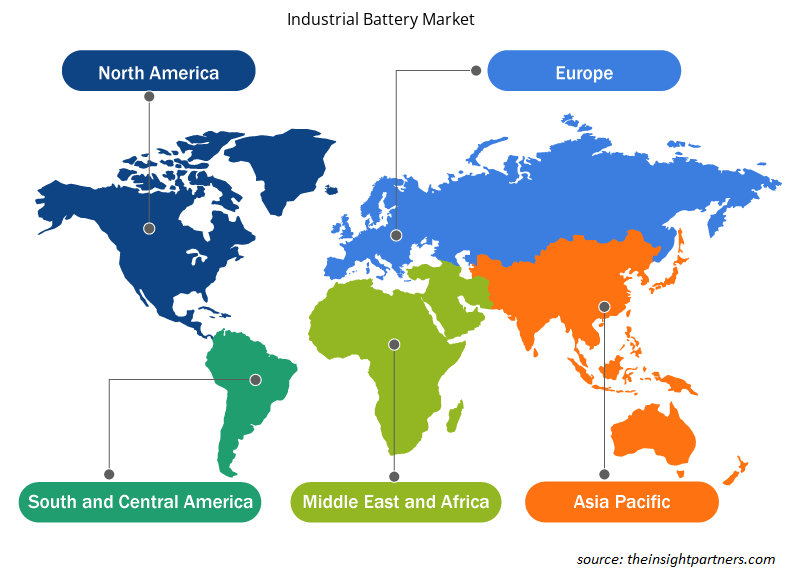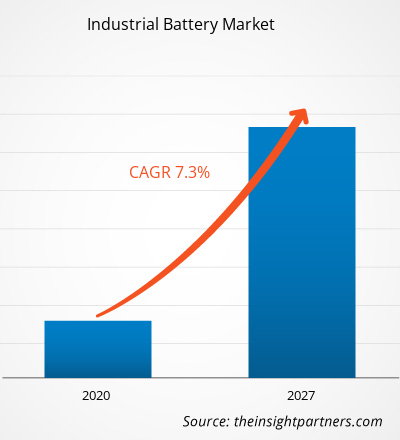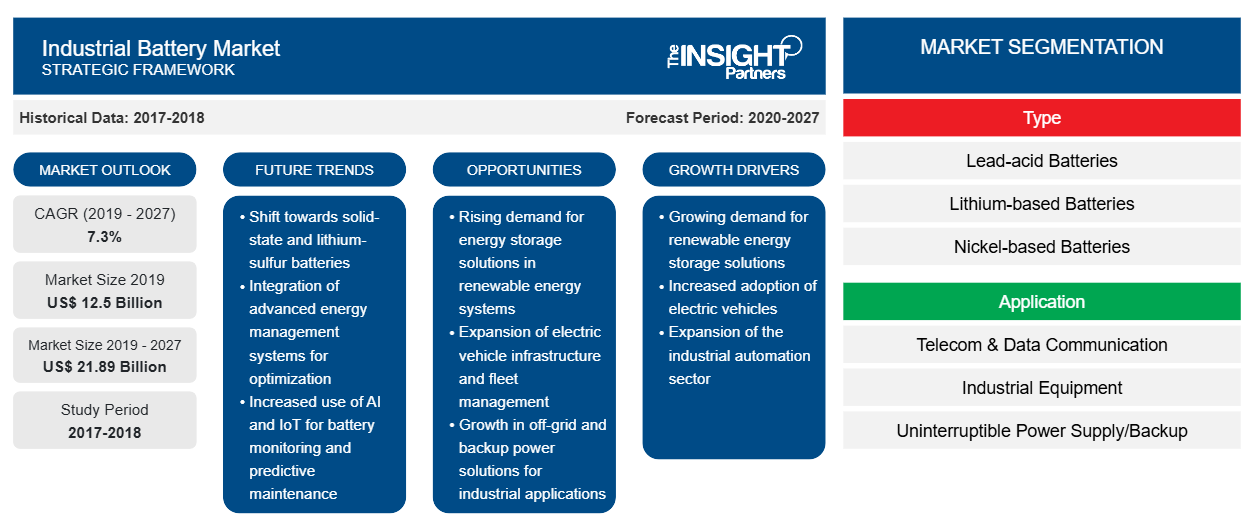بلغت قيمة سوق البطاريات الصناعية 12،501.9 مليون دولار أمريكي في عام 2019 ومن المتوقع أن تنمو بمعدل نمو سنوي مركب قدره 7.3٪ من عام 2020 إلى عام 2027 لتصل إلى 21،893.5 مليون دولار أمريكي بحلول عام 2027.
البطاريات الصناعية هي بطاريات مصممة خصيصًا يمكنها العمل في درجات حرارة صناعية قاسية مثل درجات الحرارة القصوى والمزيد من الاهتزازات والاستخدام المكثف. تعمل البطاريات الصناعية على توفير الطاقة وهي مصممة لتكون أكثر قوة. في سيناريو السوق الحالي، تعمل الشركات بجدية نحو تطوير بطاريات عالية الكفاءة تلبي احتياجات البطاريات الصناعية المتنوعة. من المتوقع أن يشهد سوق البطاريات الصناعية العالمي نموًا مذهلاً خلال فترة التوقعات. من المتوقع أن ينمو الطلب على البطاريات القائمة على الليثيوم بشكل كبير خلال فترة التوقعات. من المتوقع أن ينمو استخدام بطاريات الليثيوم عبر مختلف القطاعات الرأسية نظرًا للمزايا التي توفرها، مثل الانبعاثات المنخفضة، ودورة الحياة المتزايدة، وإمكانية إعادة التدوير. تركز الشركات العاملة في السوق على تطوير منتجات جديدة لكسب قاعدة عملاء قوية وتحقيق حصة سوقية كبيرة.
تتخذ الحكومات في دول أمريكا الشمالية، مثل الولايات المتحدة، خطوات مستمرة لتعزيز إنتاجية صناعة التصنيع. مثل توفير أحدث التقنيات لتسهيل عملية التصنيع وزيادة عدد المستودعات. ومن المتوقع أن يؤثر استخدام التقنيات الآلية في هذه المستودعات على نمو سوق البطاريات الصناعية في أمريكا الشمالية. يؤدي الإنفاق المتزايد من قبل الحكومة نحو تطوير أي تقنية. في منطقة أمريكا الشمالية، فإن الإنفاق الحكومي على أنشطة التقدم التكنولوجي مرتفع للغاية، مما يجعل المناخ مواتياً لأي عمل تجاري للازدهار. شهدت إنترنت الأشياء والبيانات الضخمة والتقنيات المتقدمة تبنيًا كبيرًا في هذه المنطقة. تعمل هذه التقنيات بدورها على تغذية متطلبات الشبكة المحسنة بالإضافة إلى الطلب على البطاريات الصناعية. من التقنيات الناشئة القليلة في سوق البطاريات الصناعية بطاريات الليثيوم أيون (Li-ion) من الجيل الجديد، وبطاريات الليثيوم والكبريت، والبطاريات الصلبة، وبطاريات الألومنيوم أيون، إلخ.
قم بتخصيص هذا التقرير ليناسب متطلباتك
ستحصل على تخصيص لأي تقرير - مجانًا - بما في ذلك أجزاء من هذا التقرير، أو تحليل على مستوى الدولة، وحزمة بيانات Excel، بالإضافة إلى الاستفادة من العروض والخصومات الرائعة للشركات الناشئة والجامعات
- احصل على أهم اتجاهات السوق الرئيسية لهذا التقرير.ستتضمن هذه العينة المجانية تحليلاً للبيانات، بدءًا من اتجاهات السوق وحتى التقديرات والتوقعات.
رؤى السوق
الحلول المتصلة بالشبكة لإمدادات الطاقة غير المنقطعة تدفع الطلب على البطاريات الصناعية
إن أبرز أنواع مصادر الطاقة المتجددة وأكثرها أهمية هي الطاقة الشمسية وطاقة الرياح التي يتم تخزينها في الشبكة. ومع ذلك، فإن تغطية الشمس بالغيوم أو التقلبات في تيار الرياح قد تؤدي إلى اختلافات في عملية توليد الطاقة. تخلق مثل هذه التغييرات الحاجة إلى أنظمة شبكة مرنة لتخزين الطاقة. تساعد أنظمة تخزين طاقة البطاريات الصناعية مشغلي الشبكة على توفير الكهرباء عندما تتجاوز كمية الطاقة الطلب على الكهرباء. وبالتالي، فإن التبني المتزايد لهذه الأنظمة يساعد في تحسين موثوقية ومرونة نظام إمداد الكهرباء فيما يتعلق بأنشطة التوليد والنقل والتوزيع. أثناء النقل والتوزيع، تتعامل أنظمة تخزين طاقة البطاريات مع جوانب مختلفة مثل تأجيل الأصول وقمع التوافقيات ودعم الجهد وتنظيم التردد وجودة الطاقة. إن التحول الزمني للطاقة الكهربائية، والتحول الزمني للطاقة المتجددة، وتسوية الحمل الأساسي، وتقليص الذروة، وتعزيز قدرة الطاقة المتجددة هي الفوائد الأخرى لاستخدام أنظمة تخزين طاقة البطاريات للحلول المتصلة بالشبكة، والتي تدفع تبني هذه الأنظمة، وبالتالي تغذية نمو سوق البطاريات الصناعية. يبتكر اللاعبون في السوق حلولاً جديدة للشبكة للحفاظ على ميزة تنافسية في سوق البطاريات الصناعية. على سبيل المثال، تقدم شركة سيمنز نظام SIESTORAGE، وهو حل ذكي للشبكات. ويستطيع نظام SIESTORAGE التغلب على التحديات التي تظهر خلال الجوانب الثلاثة الرئيسية لإمدادات الطاقة، أي تحسين توصيلات الشبكة، وتوفير الطاقة المرنة للشبكات الحديثة، ودعم كبار مستهلكي الطاقة. وعلاوة على ذلك، في يوليو 2015، عرضت شركة EDP Distribuicao على شركة SIESTORAGE التابعة لشركة سيمنز في إيفورا (البرتغال) مناقصة Storage InovGrid. ويوفر نظام SIESTORAGE خدمات مثل تنظيم الجهد، وتوفير الطاقة الاحتياطية، وتقليل فترات الذروة في استقرار شبكة EDP، ويكرر فوائد الشبكات الذكية لمشغلي الشبكة.
رؤى النوع
في قطاع النوع، استحوذت بطاريات الرصاص الحمضية على أكبر حصة في سوق البطاريات الصناعية العالمية. تتميز بطارية الرصاص الحمضية بتكلفة منخفضة وأداء عالٍ، ويمكن إعادة تدويرها بسهولة، كما أنها سهلة الشحن. إن استخدام بطارية الرصاص الحمضية واسع النطاق نظرًا لتكلفتها المنخفضة وعمر الخدمة الطويل. ومع ذلك، فإن البطارية لن تكون مناسبة للحمل العالي المستمر؛ كما أن كثافة الطاقة الحجمية لديها أقل نسبيًا، مما يجعل استخدامها غير ممكن قليلاً لتطبيقات إدارة الطاقة؛ وبالتالي فهي تستخدم بشكل أساسي لتطبيقات الطاقة. لا تزال التطورات في هذه البطارية على المسار الصحيح، مما قد يسمح لها بأن تصبح خيارًا أكثر جدوى لإدارة الطاقة.
رؤى التطبيق
يتم تقسيم سوق البطاريات الصناعية، حسب التطبيق، إلى الاتصالات السلكية واللاسلكية واتصالات البيانات والمعدات الصناعية وإمدادات الطاقة غير المنقطعة (UPS)/النسخ الاحتياطي والتعدين والبحرية وغيرها. استحوذ قطاع المعدات الصناعية على حصة مهيمنة في سوق البطاريات الصناعية العالمية. تشير اتجاهات الصناعة 4.0 المتنامية، مثل إنترنت الأشياء والذكاء الاصطناعي وتحليل البيانات الضخمة والاتصالات الشبكية والحوسبة السحابية وتقنيات التعلم الآلي، إلى تغيير كبير في طريقة عمل الشركات وكيفية تفاعلها مع عملائها. تقدم مثل هذه التقنيات المتنامية حلول معدات صناعية مبتكرة تدعم إنتاج وتسليم معدات فعالة.
تتبنى الشركات عادة استراتيجية الدمج والاستحواذ لتوسيع نطاق وجودها في جميع أنحاء العالم وتلبية الطلب المتزايد. وتُتبع هذه الاستراتيجية في الغالب في أمريكا الشمالية وأوروبا. ويتبنى اللاعبون الموجودون في سوق البطاريات الصناعية استراتيجية التوسع والاستثمار في البحث والتطوير لتوسيع قاعدة العملاء في جميع أنحاء العالم، مما يسمح أيضًا للاعبين بالحفاظ على اسم علامتهم التجارية عالميًا. وفيما يلي بعض عمليات الاستحواذ الأخيرة؛
2019: أعلنت شركة East Penn عن الاستحواذ على حصة الأغلبية في شركة Navitas Systems. ومن المتوقع أن يدعم هذا الاستحواذ توسعة عروض Motive Power Battery.
2019: أعلنت شركة Saft عن الاستحواذ على 100% من أسهم شركة Go Electric Inc.، وهي شركة مقرها الولايات المتحدة تعمل على تطوير حلول مرونة الطاقة الموزعة للشبكات الصغيرة والعملاء التجاريين والصناعيين.
رؤى إقليمية حول سوق البطاريات الصناعية
لقد قام المحللون في Insight Partners بشرح الاتجاهات والعوامل الإقليمية المؤثرة على سوق البطاريات الصناعية طوال فترة التوقعات بشكل شامل. يناقش هذا القسم أيضًا قطاعات سوق البطاريات الصناعية والجغرافيا في جميع أنحاء أمريكا الشمالية وأوروبا ومنطقة آسيا والمحيط الهادئ والشرق الأوسط وأفريقيا وأمريكا الجنوبية والوسطى.

- احصل على البيانات الإقليمية المحددة لسوق البطاريات الصناعية
نطاق تقرير سوق البطاريات الصناعية
| سمة التقرير | تفاصيل |
|---|---|
| حجم السوق في عام 2019 | 12.5 مليار دولار أمريكي |
| حجم السوق بحلول عام 2027 | 21.89 مليار دولار أمريكي |
| معدل النمو السنوي المركب العالمي (2019 - 2027) | 7.3% |
| البيانات التاريخية | 2017-2018 |
| فترة التنبؤ | 2020-2027 |
| القطاعات المغطاة | حسب النوع
|
| المناطق والدول المغطاة | أمريكا الشمالية
|
| قادة السوق وملفات تعريف الشركات الرئيسية |
|
كثافة اللاعبين في سوق البطاريات الصناعية: فهم تأثيرها على ديناميكيات الأعمال
يشهد سوق البطاريات الصناعية نموًا سريعًا، مدفوعًا بالطلب المتزايد من المستخدم النهائي بسبب عوامل مثل تفضيلات المستهلكين المتطورة والتقدم التكنولوجي والوعي المتزايد بفوائد المنتج. ومع ارتفاع الطلب، تعمل الشركات على توسيع عروضها والابتكار لتلبية احتياجات المستهلكين والاستفادة من الاتجاهات الناشئة، مما يؤدي إلى زيادة نمو السوق.
تشير كثافة اللاعبين في السوق إلى توزيع الشركات أو المؤسسات العاملة في سوق أو صناعة معينة. وهي تشير إلى عدد المنافسين (اللاعبين في السوق) الموجودين في مساحة سوق معينة نسبة إلى حجمها أو قيمتها السوقية الإجمالية.
الشركات الرئيسية العاملة في سوق البطاريات الصناعية هي:
- شركة سي اند دي للتكنولوجيا
- شركة تصنيع شرق بن
- إنيرسيس
- شركة إكسايد للصناعات المحدودة
- شركة جنرال الكتريك
إخلاء المسؤولية : الشركات المذكورة أعلاه ليست مرتبة بأي ترتيب معين.

- احصل على نظرة عامة على أهم اللاعبين الرئيسيين في سوق البطاريات الصناعية
سوق البطاريات الصناعية – حسب النوع
- بطاريات الرصاص الحمضية
- بطاريات تعتمد على الليثيوم
- البطاريات القائمة على النيكل
- آحرون
سوق البطاريات الصناعية – حسب التطبيق
- الاتصالات السلكية واللاسلكية ونقل البيانات
- المعدات الصناعية
- UPS/النسخ الاحتياطي
- تخزين الطاقة على مستوى الشبكة
- التعدين
- بحري
- آحرون
السوق العالمية للبطاريات الصناعية حسب المنطقة
أمريكا الشمالية
- نحن
- كندا
- المكسيك
أوروبا
- فرنسا
- ألمانيا
- إيطاليا
- المملكة المتحدة
- روسيا
- بقية أوروبا
آسيا والمحيط الهادئ
- الصين
- الهند
- كوريا الجنوبية
- اليابان
- أستراليا
- بقية آسيا والمحيط الهادئ
الشرق الأوسط وأفريقيا
- جنوب أفريقيا
- المملكة العربية السعودية
- الامارات العربية المتحدة
- بقية الشرق الأوسط وأفريقيا
أمريكا الجنوبية
- البرازيل
- الأرجنتين
- بقية أمريكا الجنوبية
ملفات تعريف الشركات
- شركة سي اند دي للتكنولوجيا
- شركة تصنيع شرق بن
- إنيرسيس
- شركة إكسايد للصناعات المحدودة
- شركة جنرال الكتريك
- شركة جي اس يواسا الدولية المحدودة
- إل جي كيم
- شركة باناسونيك
- شركة روبرت بوش المحدودة
- مجموعة صفط SA
- التحليل التاريخي (سنتان)، سنة الأساس، التوقعات (7 سنوات) مع معدل النمو السنوي المركب
- تحليل PEST و SWOT
- حجم السوق والقيمة / الحجم - عالمي، إقليمي، بلد
- الصناعة والمنافسة
- مجموعة بيانات إكسل
التقارير الحديثة
تقارير ذات صلة
شهادات العملاء
سبب الشراء
- اتخاذ قرارات مدروسة
- فهم ديناميكيات السوق
- تحليل المنافسة
- رؤى العملاء
- توقعات السوق
- تخفيف المخاطر
- التخطيط الاستراتيجي
- مبررات الاستثمار
- تحديد الأسواق الناشئة
- تحسين استراتيجيات التسويق
- تعزيز الكفاءة التشغيلية
- مواكبة التوجهات التنظيمية





















 احصل على عينة مجانية ل - سوق البطاريات الصناعية
احصل على عينة مجانية ل - سوق البطاريات الصناعية